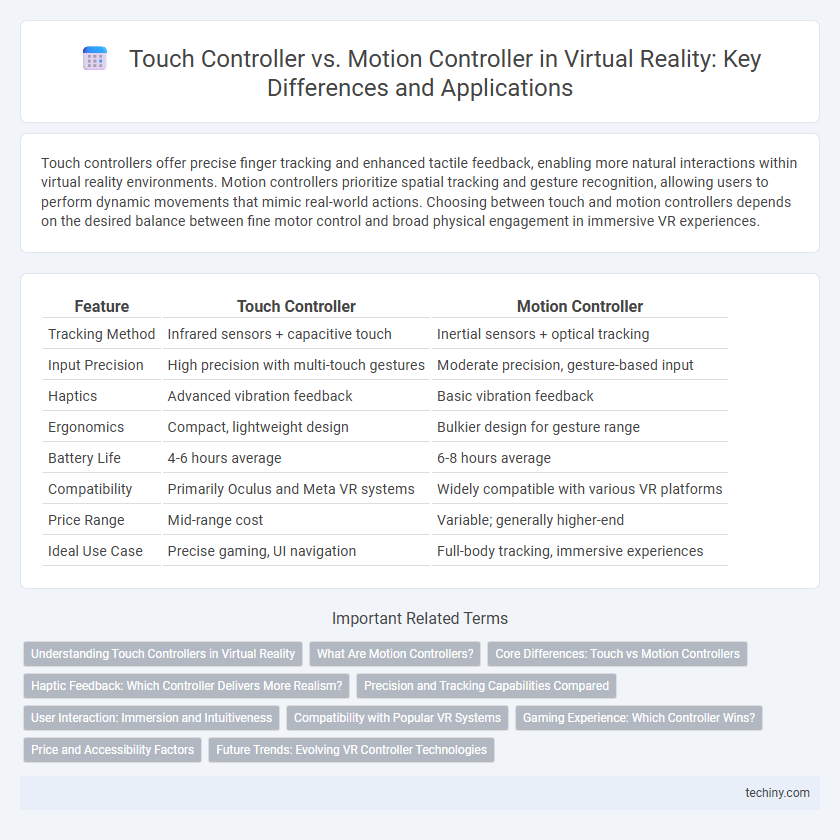Touch controllers offer precise finger tracking and enhanced tactile feedback, enabling more natural interactions within virtual reality environments. Motion controllers prioritize spatial tracking and gesture recognition, allowing users to perform dynamic movements that mimic real-world actions. Choosing between touch and motion controllers depends on the desired balance between fine motor control and broad physical engagement in immersive VR experiences.
Table of Comparison
| Feature | Touch Controller | Motion Controller |
|---|---|---|
| Tracking Method | Infrared sensors + capacitive touch | Inertial sensors + optical tracking |
| Input Precision | High precision with multi-touch gestures | Moderate precision, gesture-based input |
| Haptics | Advanced vibration feedback | Basic vibration feedback |
| Ergonomics | Compact, lightweight design | Bulkier design for gesture range |
| Battery Life | 4-6 hours average | 6-8 hours average |
| Compatibility | Primarily Oculus and Meta VR systems | Widely compatible with various VR platforms |
| Price Range | Mid-range cost | Variable; generally higher-end |
| Ideal Use Case | Precise gaming, UI navigation | Full-body tracking, immersive experiences |
Understanding Touch Controllers in Virtual Reality
Touch controllers in virtual reality are designed to provide intuitive hand presence by tracking finger movements and gestures with high precision, enhancing user interaction within VR environments. Unlike traditional motion controllers that primarily capture hand position and orientation, touch controllers utilize capacitive sensors to detect individual finger placement and pressure, enabling more natural input methods such as pinching and gripping. This technology significantly improves immersion by allowing users to manipulate virtual objects more realistically and engage seamlessly with complex VR applications.
What Are Motion Controllers?
Motion controllers in virtual reality are advanced input devices that track hand movements and gestures to provide a more immersive experience. Equipped with sensors like accelerometers and gyroscopes, they detect precise motion and orientation, allowing users to interact naturally within the virtual environment. Unlike traditional touch controllers, motion controllers emphasize spatial tracking to enhance realism and improve user engagement.
Core Differences: Touch vs Motion Controllers
Touch controllers utilize capacitive sensors to detect finger positions and gestures for precise input, while motion controllers rely on accelerometers and gyroscopes to track hand movements and orientation. Touch controllers enable direct interaction with virtual objects through button presses and touch gestures, offering nuanced control in VR environments. Motion controllers provide broader spatial tracking, allowing for immersive arm and hand movement replication but with less finger-level precision compared to touch controllers.
Haptic Feedback: Which Controller Delivers More Realism?
Touch controllers offer advanced haptic feedback with precise vibration motors that simulate textures and impacts, enhancing immersion in virtual reality environments. Motion controllers provide broader motion tracking but generally deliver less nuanced haptic sensations compared to touch controllers. For users prioritizing realistic tactile experiences, touch controllers deliver more detailed and responsive haptic feedback, elevating the sense of presence in VR.
Precision and Tracking Capabilities Compared
Touch controllers offer high precision and responsive haptic feedback, enhancing user interaction with virtual objects through capacitive touch and pressure sensors. Motion controllers excel in tracking broad, natural hand movements using advanced inertial measurement units (IMUs) and optical sensors, delivering robust spatial awareness in VR environments. While touch controllers prioritize fine motor control and tactile accuracy, motion controllers enable immersive, full-hand gestures for broader motion detection.
User Interaction: Immersion and Intuitiveness
Touch controllers enhance user interaction in virtual reality by providing precise haptic feedback and intuitive button layouts, allowing users to perform delicate tasks with greater accuracy and immersion. Motion controllers, on the other hand, rely on tracking hand movements and gestures, offering a natural and fluid interaction that mimics real-world motion but may lack detailed tactile responses. Combining both technologies can optimize immersion and intuitiveness, catering to diverse user preferences and complex VR environments.
Compatibility with Popular VR Systems
Touch controllers offer extensive compatibility with popular VR systems like Oculus Quest, HTC Vive, and Valve Index, featuring intuitive button layouts and precise haptic feedback. Motion controllers excel in tracking dynamic hand movements and gestures, commonly supported by systems such as PlayStation VR and Oculus Rift S. Compatibility depends on the VR platform's hardware integration and software support, impacting the user's immersive experience and interaction accuracy.
Gaming Experience: Which Controller Wins?
Touch controllers offer precise haptic feedback and intuitive button layouts that elevate gaming immersion, allowing players to interact naturally with virtual environments. Motion controllers excel in tracking complex gestures and full-body movements, enhancing physical engagement and realism in VR games. For gaming experience, touch controllers typically win for precision and comfort, while motion controllers dominate in dynamic, movement-intensive gameplay.
Price and Accessibility Factors
Touch controllers generally offer a more affordable and user-friendly option for virtual reality users, with widespread compatibility across popular VR systems like Oculus Quest and HTC Vive. Motion controllers, often featuring advanced motion tracking and ergonomic designs, tend to be higher-priced and may require specific VR hardware, potentially limiting accessibility for budget-conscious buyers. Price and accessibility remain key factors influencing the choice between touch and motion controllers within the VR ecosystem.
Future Trends: Evolving VR Controller Technologies
Future VR controller technologies are increasingly integrating haptic feedback and adaptive grip sensors to enhance immersion and precision. Advancements in machine learning and sensor fusion are driving the development of hybrid controllers that combine touchscreen functionality with motion tracking capabilities. These innovations aim to create more intuitive and responsive interfaces, bridging the gap between physical and virtual interactions.
Touch controller vs Motion controller Infographic

 techiny.com
techiny.com